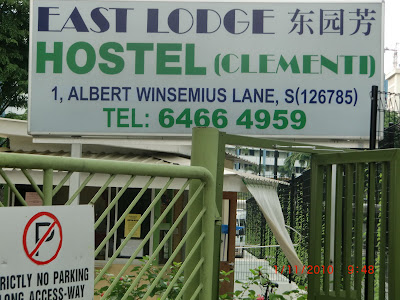
a smaller version of the memorial at the japanese cemetery park
the 135 concrete steps
the bukit batok memorial
once in a while, when i am at bukit batok nature park, i will see a bus-load of japanese tourists alighting at the foot of the 135 concrete steps. if you do not know the history of the place, you may wonder: what is the attraction for this whole bus-load of tourists? are they here to see the mediacorp transmission towers at the top of the hill? or are they here to see the 'big book' - the bukit batok memorial? no, they are there for another reason.
after the war, the japanese consigned 500 australian prisoners of war to build a memorial to the japanese soldiers who died in the malayan campaign. the japanese commander lieutenant-general yamashita had chosen this site for the memorial because the fiercest battle in singapore was fought there, somewhere near the ford motor works.
the japanese memorial was known as the syonan chureito (syonan war memorial). it was a 13m high cylindrical wooden pylon with a brass cone at the top. the ashes of the japanese soldiers who died in the battle of bukit timah were buried there. not far behind it, there was another memorial - a 3m high wooden cross - dedicated to british soldiers who died in the same battle. there was also a small japanese shrine near the chureito.
what happened to the two memorials and the shrine? when the japanese surrendered in 1945, the returning british forces demolished the memorials and the shrine. according to one report, the wooden cross was destroyed inadvertently. another report said that the wooden memorial failed to withstand the elements of nature and the passage of time. today, if you go to the site, beyond the fence, you cannot see any trace of them.
my friend, who was a teenager during the occupation, had seen both the chureito and the wooden cross. he was working for the japanese military command then. every year, on new year's day and on the anniversary, he would be taken to the site to pay his respect - by bowing three times - in the direction of the chureito.
it was customary for japanese employers to take their local civilian staff to pay their respect at the chureito. in fact, the japanese authorities made it compulsory for the leaders of all the communities to pay homage at the chureito.
today, the 135 steps are the only reminder that at one time the presence of the japanese conquerors was very evident in this area. the original steps were rough and not so well aligned. today, there is an information panel, put up by singapore tourist promotion board, that gives a bit of history of the place.
the 13m obelisk was so high that it could almost been seen from bukit timah road. these days when the tourists visit the spot, it is only their imagination that will enable them to see the obelisk.





















































